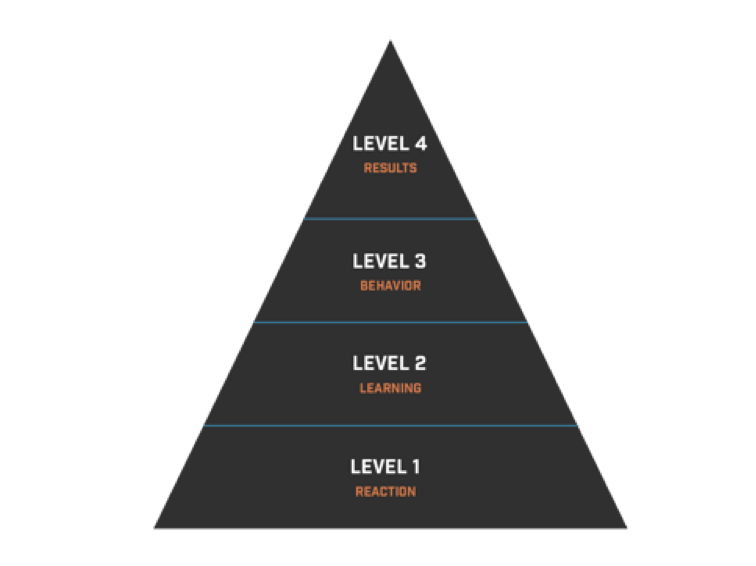How To Assess The Impact Of Your Training?
Any training—be it a classroom, Virtual Instructor-Led, or digital learning experience—must positively impact the learners’ minds and hearts. When there is a positive impact, there are better chances of remembering the concepts and their application to the job. One must assess what impact it will result in and what difference it will make. There also comes the factor of being motivated to ensure the desired impact is seen, which now surpasses the old norm of “What’s in it for me?” (WIIFM). When these two are identified, designing how to reach this impact becomes more apparent. Then it is all about delivery and evaluation. In this article, I will discuss 4 ways to assess the impact of your training using the Kirkpatrick model.
As per the ADDIE course development model, the last phase is the evaluation. Evaluation is about how impactful the course was on the learners and how beneficial it was for the employees and the organization. An important model to measure the impact of the course is Donald Kirkpatrick’s model on 4 levels of training evaluation.

As per this model, there are 4 levels of measuring the training impact. Let’s look at each level in brief.
Level 1: Reaction
The base level, or the first level, is the reaction—the immediate reaction to a course. Here we can measure how the learners found the course. Whether the course was fun, engaging, and relevant to the tasks they perform or their job. L&D teams use smiley sheets and surveys to rate the course experience. This can be used for both classrooms that are offline sessions as well as for digital learning experiences. For a digital learning experience, you can use the online survey forms. It is also known as an after-training survey.
Level 2: Learning
The second level of the Kirkpatrick model talks about measuring the learning that is gained in the course. So, how can we measure learning? It is generally done by using assessments. There are two methods: formative and summative. For example, knowledge checks and “check your understanding” are the types of questions that fall under the category of formative assessment.
Summative assessment is generally conducted after the training, that is, as a post-learning assessment. These assessments measure if the learners were able to understand the concepts better. In the LMS, a minimum criterion, like 80% or 90%, can be set as the qualifying or passing criterion.
Other methods include in-person interviews, group discussions, and role-plays to gauge if the learners were able to learn and apply the concepts well.
Level 3: Behavior
The third level is to know if there have been behavioral changes post training. This is slightly difficult to gauge, but there are methods that can be used. Periodic feedback meetings, peer group sessions, and checking whether the learners are applying the learning to the job are some methods to measure the behavioral impact.
Level 4: Results
The fourth level is about results. Did the training have a good impact on business results? For this, the L&D department and business need to have a robust framework wherein the KPIs and learning metrics are all linked in a structured manner. Sometimes the results may not be a direct result of training. They could simply be good sales and marketing practices. Thus, be careful when tying Key Performance Indicators to learning metrics.
Training such as compliance or safety training can be linked to metrics such as fewer errors, fewer accidents, and so on. However, the training teams need to work closely with the business to measure the results and have solid metrics.
How To Assess The Training Impact In Learning Platforms?
Using a learning platform like KREDO can help measure the various aspects of learning, as enumerated above. KREDO has in-built analytics that help L&D teams measure the impact of learning programs.
The presence of sharp and distinct learner performance analytics is the core of a learning environment. In KREDO, both canned and custom reports are available to look at learner performance and engagement, including reporting the learning business metrics. The type of questions we address include:
- What impact does the training have on specific business objectives?
- How much time does a user spend on a course or module?
- What type of content needs to improve?
- What knowledge gaps do users have, and where is additional training needed?
- What data visualization patterns help administrators identify the trends?
- How to measure the effectiveness of L&D programs from organization-wide metrics?
- How to build workforce readiness, confidence, leadership abilities, etc., based on data analytics and reports?
- How to improve the KPIs and other metrics based on identified data?
Conclusion
To conclude, the Kirkpatrick model is a good starting point for measuring the impact of learning programs on employees. One can measure the reaction, learning, behavioral changes, and results. However, one must have a good framework to tie to the metrics.
At Tesseract Learning, our learning and visual architects constantly innovate and reinvent their approaches to design, develop, and deliver effective L&D programs. We are leveraging our powerful learning platform, KREDO, to create efficiencies across the training life cycle and deliver optimal learning experiences.
Contact me or leave a comment below to learn more about our services and how we can help you.

Tesseract Learning Pvt Ltd
Tesseract Learning works with global organizations improve employee performance through spectrum of digital learning solutions. Solutions include eLearning, mobile learning, Microlearning, game based learning, AR/VR, Adaptive learning amongst others.




















